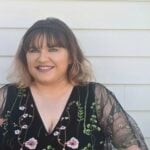Keri Gray was 8 years old when she was diagnosed with osteosarcoma. The bone cancer resulted in Gray having her leg amputated when she was 9, an experience she said she didn’t fully process until she was in college.
“At that point in time, there was just so much going on and I was so young,” Gray said. “I was focused on what this means in terms of being able to make friends, being able to exist in social settings. I didn’t think that being a vibrantly disabled girl would help me in that matter. … I think at that point, I just wasn’t identifying as someone with a disability.”
When Gray got to college, however, she met others living with disabilities who were actively involved in the disability rights movement. After an internship with the American Association of People with Disabilities, Gray began embracing her disability, a shift she said led to a professional and personal journey.
While the Americans with Disabilities Act, which was passed in 1990, was a good starting point, there are many ways those with disabilities are forgotten about.
Rep. Edward Clere, R-New Albany, tried to rectify some of the issues with House Bill 1313, which would allow record sharing between agencies to help Indiana students with disabilities find resources for training, education opportunities and employment. The bill returned to the House with amendments March 24.
Gray started the Keri Gray Foundation and founded the National Alliance of Multicultural Disabled Advocates (NAMDA). Through the Keri Gray Foundation, Gray consults with organizations on how to approach and discuss disability access. Through NAMDA, she organizes and networks with disabled people within minority populations to “invest in their livelihood and leadership.”
On a personal level, Gray realized her experiences with disability and the experiences of many Black women with disabilities were different than those of other demographics.
“I am a Black woman with disabilities,” Gray said. “It’s vital that I’m always bringing my own perspective into spaces, and racial justice is interdependent to disability justice and vice versa. There are many other people who identify at those intersections.”
Intersectionality is a term coined by Dr. Kimberle Crenshaw to describe “the experience of living with multiple identities (gender, race, culture, disability, gender identity, sexual orientation, immigration status, etc).” For example, Gray said the experiences of Black women differs from those of Black men and non-binary African Americans, more so if someone is also disabled.
Throughout the pandemic, disparities between Black and white Americans have been widely discussed, but people with disabilities have largely been left out of the conversation. However, Gray believes some changes made throughout the pandemic that benefitted many people — not just disabled folks — may stick around, including working from home and curbside pickup for restaurants and shops.
“The pandemic definitely changed a lot and it did a lot to impact workplace culture,” Gray said. “All of a sudden, everybody has to figure out how to change the ways we work and exist with each other. I don’t know if people are viewing these changes as accommodations, because right now they’re benefitting everyone … but I think it’s made a lasting impression for folks.”
Inequities those with disabilities face aren’t just limited to accessibility, but are impacted by how individuals are perceived, as well. The National Institute of Health estimates students with disabilities are referred to juvenile justice at rates five times higher than students without disabilities. These rates are higher for Black and Latinx students. Further, 26% of Americans with disabilities live below the poverty line compared to 11% of those without disabilities. Black and Indigenous people with disabilities have the highest rates of poverty.
Gray said the path toward equity and accessibility begins with advocating for yourself. She said she got no pushback when she started embracing her disability by wearing shorts or describing herself as disabled. It’s when she started speaking out about injustice and inaccessibility that she began clashing with others. As a Black woman, she said getting spoken over isn’t anything new.
“Black women, I just want to affirm your existence, affirm your leadership and affirm everything that you give that goes unrecognized,” Gray said. “… I encourage Black women to love themselves to the fullest extent. … We deserve spaces and communities that will love, cherish and support Black women.”
Contact staff writer Breanna Cooper at 317-762-7848. Follow her on Twitter @BreannaNCooper.










